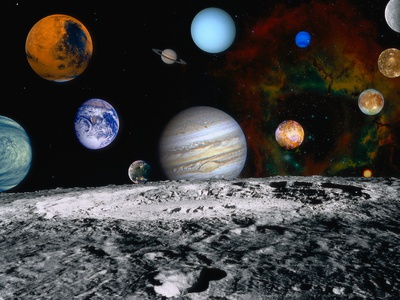See All Five Naked-Eye Planets!
Star gazers have an good opportunity this month to see all five
naked-eye planets. Begin by looking low in the western sky about 45
minutes after sunset. Here you will find a line of three planets -- Mars
(lowest), Jupiter (middle) and Saturn (highest). Jupiter is the
brightest of the group and the easiest to find. Look for a brilliant
white "star" in the western sky. It's not a star at all but the planet
Jupiter.
Apart from the Moon, Jupiter is the brightest object in the evening sky
at the moment. However, unlike a star the light we see from Jupiter and
other planets is not emitted by the planet but is instead reflected
sunlight. In the same way that we see the Moon by reflected sunlight we
also see the planets.

Click Here for Information or to Buy this Poster
A few degrees away from Jupiter and higher up in the sky is the
beautiful ringed planet Saturn (a small telescope will show the rings).
Although fainter than Jupiter, Saturn shines with a steady yellow color
and is quite easy to find. Mars is the most difficult of the three
planets to see because it is presently relatively faint and quite low in
the sky. Extend a line from Saturn through Jupiter to find Mars. Look
for a red or orange colored "star" and you will have found the planet
Mars. Use a pair of binoculars if necessary.
Of special interest to star gazers this month will be the evenings of
March 8 to 10 when the thin crescent Moon will be located near Mars,
Jupiter and Saturn one evening at a time. Make a special effort to view
this most beautiful of celestial sights.
The most elusive of the five naked-eye planets is Mercury. It is the
closest planet to the Sun and is difficult to see because much of the
time it is "lost" in the bright light of the Sun. However, in the
pre-dawn sky on March 15 and 16 Venus, the brightest planet in the sky,
will be your guide. On this morning, Mercury will be located just 2
above Venus. Find brilliant Venus very low in the eastern sky about 25
minutes before sunrise, and there just above will be Mercury, the most
elusive planet of all. You may need a pair of binoculars to detect the
two planets in the bright twilight.
Clear skies until next month!
Related Links:
Related Books:


